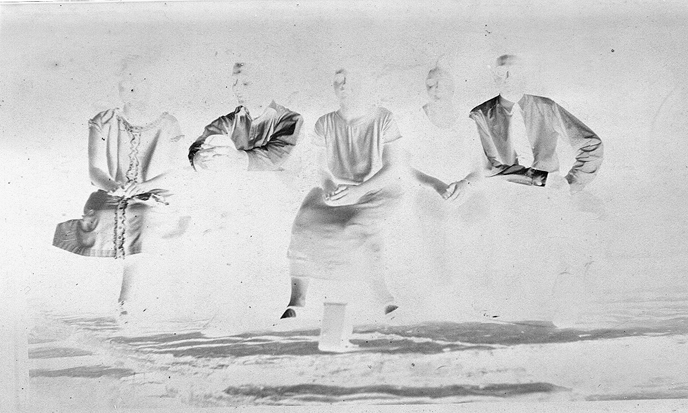(de)Constructed Ghosts: Liner Notes

When I first heard mention, on a newsgroup in 1993, of Eldon Chorashan's legendary "Kirlian audio" sound analysis software, I was skeptical. Visual Kirlian or "radiation field" photography, by use of a "multiplier" which produces extremely high voltage but low current, raises the intensity of normally invisible ion collisions with a photographic subject (living or inanimate) to the point that the subject exhibits "corona discharge" or electroluminescence. This is the "aura" seen emanating from the subject in a Kirlian photograph, a visual representation of the subject's energy field.
Chorashan, a former pupil of Semyon Davidovich Kirlian, believed that an analogous process that he called "hyper-timescale threshold gating," performed on digital audio waves, could produce audioluminescence. Chorashan thus believed it was possible, using the appropriate sound analysis software, to produce an audio document representing the hidden "historical energy artefacts" produced by all entities which emit sound. In other words, Chorashan believed that within all sounds is encoded historical material, echoes of the past(s) of the objects producing the sound, which may be isolated using the proper stimuli.
Chorashan supposedly developed just such a software program, while working for the CIA's infamous OREAD "acoustic warfare" project in the 1970s. I obtained a copy of this highly illegal software, Ligea, from the now defunct Anarchy 'N' Explosives FTP download site in 1996. This version of the software had several of Chorashan's original more controversial features disabled, but nevertheless was promised to be capable of rendering the audio "aura snapshots" described above, given 16-bit, 44 khz audio input into a properly equipped UNIX workstation.
It was only late in 1999 that, finally overcoming the steep learning curve and lack of documentation associated with mastering Ligea, I realized my first audioluminescent documents ("polybus transforms" in Chorashan's cryptic language). For these initial experiments, I used a few seemingly benign and mundane sound sources: random noise generated internally by a Power Macintosh 7300 computer, field recordings from construction sites in Siem Reap, Cambodia and Seattle, Washington, the rehearsal sessions of a special education theater troupe in San Francisco, and tapping and other physical environmental disruptions onboard a retired art-deco 1950s/60s automobile ferry in Seattle.
What you will hear on the (de)Constructed Ghosts CD are the auras, if you will, of these sources, rendered by Ligea. Portions were selected from the raw Ligea material for looping, layering and stereo separation. No other processing has taken place.
Continue Reading...
Back to the main (de)Constructed Ghosts page